NO ONE HAS SEEN OR HEARD FROM THE CYLONS IN OVER FORTY YEARS.



From the moment a Cylon Base Star arrives at a lone space station outpost and a blonde, sexy, female Cylon (Tricia Helfer) struts toward the surprised officer (Ryan Robbins) we are immediately put on notice Battlestar Galactica is back, big, bad, all new and all different.
Helfer questions the officer "Are you alive?" and proceeds to kiss the man passionately.
Ghost In The Shell (1995), Blade Runner (1982) and others have asked what becomes of artificial intelligence when it becomes self aware among other existential questions. In general terms, it too wants to live.

Battlestar Galactica (2003-2009) intelligently takes those concepts and ideas to the next level. Writer/Creator Ronald D. Moore not only infuses and fires off his opening salvo with such existential questions, but does so through a vivid pronouncement of female empowerment in the form of the sexy Number Six Cylon model as embodied by Helfer.
It has begun. With the opening destruction of the space outpost destroyed by the base star, Battlestar Galactica: The MiniSeries (2003), opens its story with one of the most unsettling, dark and disturbing sequences this writer could recall in science fiction memory. It was a crushing, unforgettable scene. One for the ages. The sheer power in that stunning moment of annihilation would remain with me.

The opening sequence darkens Helfer's entrance painting her as a deceptive beauty disguising a lethal combatant.
The officer peruses papers on the Cylons as we recollect them in their original series form. Large, strong but inefficient. Decades on, the arrival of the new Cylon is unexpected, beautiful and deadly like a devil in a red dress. In fact, unlike humans, and humanity, as the Cylon Base Star destroys the space station it takes out its own Number Six model, as well as two Centurion Cylons with the cool efficiency of machine calculation. Humans are indispensable. Cylons, on the other hand, are not. They are indeed dispensable, replaceable.
The answer to the Colonial officer's life is met by the Cylons with his death, a death incapable of rebirth.

Yet, the Cylon, Number Six, will simply download or upload into another vessel or shell so her ghost will live again. Thus death without resurrection is the proof of life to Cylons. In many respects these children of humanity pursue life like the replicants of Blade Runner once pursued life.
In an article called The Face In The Mirror: Issues Of Meat And Machine In Battlestar Galactica from the book So Say We All, writer Natasha Giardina noted, "humanity's children" are much like "Frankenstein's monster, they are flawed children who desire the destruction of their flawed creators" though ultimately desiring to have what they have and a desire to supplant them. These flawed, petulant children are coming home and that is understated in a very powerful, visual opening.
Finally, the sequence is also beautiful in its execution. There is a distinctly visual vision here and Helfer's understated performance is not unlike the work of a Sean Young as Rachel in the aforementioned science fiction classic Blade Runner. The Mini-Series opening is a gem.

Moore's Battlestar Galactica loosely touches upon Glen A. Larson's epic Saga Of A Star World here. Ultimately though the eventual series is an entirely different beast.
For this writer Battlestar Galactica is one of those stories I love in its many forms. The story, like Star Trek, is one constantly ripe for reevaluation.
With the opening titles, a propulsive, militant drum beat, compliments of composer Richard Gibbs, kicks off one of the most satisfying, accompanying scores in memory. The music for The Mini-Series and for the series proper (falling to Bear McCreary) would devastate me with its raw emotion and devastating power for years to come. The music, a character to the series itself, stands on its own as a work of art.

The story begins.
Crew members are passing their well wishes on to Commander William Adama bidding him farewell following his tour aboard the Battlestar Galactica. The Galactica herself, "the last of her kind," is one of twelve original Battlestars constructed fifty years earlier for the Cylon War. Each represented a colony of Kobol. The Galactica represented Caprica.
The Galactica was intentionally designed backward with a heavy reliance on older technology to properly counter the more sophisticated technology of the Cylons. Antiquated systems were the rule of the day in order to survive the enemy they themselves created. Commander Adama makes it clear he will not allow an integrated computer network aboard the Battlestar Galactica. "Let me explain something to you, many good men and women lost their lives aboard this ship because someone wanted a faster computer to make life easier," declares Adama in opposition to networking.

Homage to the original series is quickly established through the card-playing, cigar chomping character of female character Kara Thrace "Starbuck." It also echoes a card scene featuring Dirk Benedict as Starbuck from the classic series. It's made clear very early on that Starbuck has a nasty, antagonistic relationship with the ship's XO (executive officer), Colonel Saul Tigh (Michael Hogan), a man with a strong affinity for the bottle.
Katee Sackhoff (Longmire) is excellent as hot shot pilot Starbuck along with a universally exceptional cast.
The story relocates and alternates from the Galactica to Caprica City. We are introduced to Laura Roslin (Mary McDonnell) where she learns of a personal malignancy.

Elsewhere a Number Six model snaps the breathing passageway of an infant baby. It is a dark moment and as unsettling as network science fiction seems gets.
On Caprica we finally meet Dr. Gaius Baltar (James Callis) working as a consultant to the ministry of defense and a man in favor of re-establishing controversial research into artificial intelligence banned since the Cylon Wars. Callis is another divine find for the series alongside the stars, Helfer, Hogan and Sackhoff.
Also stunning is Battlestar Galactica's no holds barred approach to this series as Number Six enters Baltar's home and proceeds to fuck him. It's as sexy and hot as the series herself. In the only moment I can recall, the spine of Number Six lighting red for the sequence.

Six uses her intelligence and sexuality as a weapon gaining access to defense secrets.
My colleague has an expression he enjoys citing from time to time with a bit of humor. Whilst making a gesture of the female anatomy with his thumb and index finger in the form of a sliver, he notes, "women---they have brought down empires" and he's not wrong when you look through history. And Six is about to bring down Caprica.
But there is something else happening with Six or Caprica Six. She asks Baltar, "do you love me?," because Cylons are searching for all of the things endowed to their creators. They desire life, the capacity to love and feel and Six expresses these capacities to Baltar. Six also suggests differences following each mission and download. What if with each download delivered a slight change or variation occurs imprinting things newly discovered. At the same time, Baltar does not answer Number Six because he too lacks the capacity for love. That dynamic expresses how complicated we are. It is also underscores how close behaviors are between the Cylons and humanity. They are almost indistinguishable. And therein lies one of the ongoing themes throughout the series---telling humans and Cylons apart.

Captain Lee Adama, aka Apollo (Jamie Bamber), arrives aboard the Galactica in a renewal, but loyal interpretation of the Viper.
The relationship between Lee and his father William Adama would be one of the many significant relationship arcs throughout Battlestar Galactica's run. Additionally, it's worth noting, there is a striking parallel that would be mined for the prequel series Caprica (2010) between a young William Adama and his own father Joseph Adama (Esai Morales). Troubled relationships seem to define the Adamas, but also relations in general on the new series versus the classic Battlestar Galactica.
On Caprica it's clear that Baltar has betrayed humanity by allowing Six to access the defense mainframe of Caprica. Sadly, Baltar is so self-absorbed he hardly realizes he has sealed the fate of the colony.


Six also eludes to her faith in one God, a monotheistic faith, which runs counter to the polytheistic faith of humanity. The faith inversion creates identification with the Cylons and places the Colonials in a kind of historic Greek context.
Among the many contentious relationships and/or interesting arcs for them is the one between William Adama and Laura Roslin which begins here. Apollo and Starbuck. Lee Adama and his father. Six and Baltar. The list of fascinating character dynamics goes on throughout the series.
Dirk Benedict and Richard Hatch made history in the original series but so too do the partnerships and conflicts forged here in the new series. Olmos is always impressive as the pained and burdened veteran officer turned commander.

Clearly gone are the days of warmth between father and son Adama, a bond that was central to the original series as written by Glen A. Larson.
In essence, the new series eschews the traditional, conservative, family values supplanting it with dysfunction and distrust.
Whereby Zak Adama's death brought father and son together in the original series, Zak's death here has created a tear in the fabric of the father/son dynamic as well as influencing the dynamic of Apollo and Starbuck.

In many respects, the decommissioning ceremony aboard the Galactica, is a symbolic decommissioning of the classic series. This is portrayed through a tribute to classic Cylon accoutrements from the classic series surrounding them in the museum. The homage continues as composer Gibbs also infuses the moment with the profile and themes of the classic series once orcehstarted by Stu Phillips.
Baltar offers one of the most fascinating characters caught in a game between Cylons and his own humanity. Baltar, while infinitely shallow also demonstrates a conscience. He is tricked, duped and made a fool, the victim of the carnal, primal desire for sex with an indescribably attractive, leggy blonde named Six to whom he sold out humanity for fucking. Six is sex.
Baltar rears his ugly head when an instinct and capacity for self-preservation kicks in concerned for who on Caprica might be aware of his transgression, of his betrayal. The fact Caprica's defenses have been compromised by the enemy are of little consequence to an infinitely selfish Baltar.

As Six notes, "humanity's children are returning home... today." And so the end of Caprica begins.
Those aboard the Galactica are the lucky ones or are they? Aboard the Galactica the decommissioning ceremony has commenced while the annihilation begins on Caprica below.
In space, Adama reflects before a crowd, "The cost of wearing the uniform can be high, ... sometimes it's too high." Gone is the noble, hopeful flair and optimism of Lorne Greene's Adama. In its place, we have scarred humanity.
Here is that speech from the dark recesses of the human heart. This is the anti-original Battlestar Galactica speech. This is hardly inspiring stuff and clearly places the new Battlestar Galactica in a different mirror.

"When we fought the Cylons we did it to save ourselves from extinction. But we never answered the question why? Why are we as a people worth saving? We still commit murder because of greed, spite, jealousy and we still visit all of our sins upon our children. We refuse to accept responsibility for anything that we've done like we did with the Cylons. We decided to play God, create life. When that life turned against us we comforted ourselves in the knowledge that it really wasn't our fault---not really. You cannot play God and then wash your hands to the things that you've created. Sooner or later the day comes when you can't hide from the things that you've done anymore."
This is an awfully fitting speech when juxtaposed with the fate that awaits Caprica. Splicing images of the attack on Caprica over the speech might have been perfect. Most of the attack on Caprica, unlike the classic, sees the action take place off camera and maintains focus on the characters and their sober responses giving this new Battlestar a more unsettling intimacy.

For those at odds over the approach here, it's not that the speech doesn't have merit. It's not that such words don't warrant consideration or heartfelt reflection. These words do. But sometimes people need to be lifted not with ugly truths, but rather with the good men and women do. This is important for the soul. It nourishes our existence when we sometimes desperately need it. This is something I felt Obama never understood as President. Yes, America, like human beings, have their shortcomings but we need not be reminded of them time and again for eight years.
It's ironic that the hawkish Adama represents aspects of the passive negative or active negative found in the analysis of William Barber. This typology was well represented by Barack Obama too.

But when I stop to consider the speech given by Adama it works within the context of The Mini-Series. The war weary Adama is coming from a genuinely dark place, a tired place and Olmos nails the performance. So while I don't agree philosophically or politically with approaching a people in this manner I can understand the post-war mindset and Adama's mental state as he prepares for retirement with a certain peace, acceptance or understanding. God knows he still hates those Cylons.
"What have I done?," asks Baltar of himself with overwhelming guilt, tears streaming from his eyes and hands clasped prayerfully. The devastation and death feels like something ripped from the headlines today. Callis is impeccable in selling the scene. While he is a callow, loathsome character even pathetic he manages to capture a good degree of empathy from the viewer as circumstances unfold into the dire consequences of his actions. We are at once disturbed and saddened.

We are also surprised by Baltar seeing Six as nothing more than a gift of the flesh. Baltar has a knack for "self-deception" as Six suggests, which is why this moment of revelation is so powerful as we witness Baltar struggle with his humanity.
Baltar angrily demands how Six will escape. She is Six of twelve Cylon models. She will not die. She will simply download into another physical shell. Her ghost will enter another shell. She will live again somewhere else. This of course previews episodes to come in the series proper like Downloaded (Season Two) or The Hub (Season Four).
As the assault on Caprica occurs, Six saves Baltar. Is this an act of love? She shields Baltar with her physical self. This act alone will establish questions regarding the Cylons throughout the series.

Earlier Six stops to admire the baby, a small, fragile life. If Six values life are these moments of free will outside the framework of the Cylon mission. When she snaps the baby's ability to breath after admiring it, is this an act of mercy or compassion rather than sheer brutality knowing what fate awaits Caprica?
The attack begins. The Galactica is alerted. As the camera shakes and moves cinema verite style throughout the ship like a documentary the creators put us smack dab in the urgency and action of the moment.
Adama steps in and takes charge with no hesitation. This is the Adama you love over the course of the series. He informs his people with a razor-like focus, "How? Why? Doesn't really matter now. What does matter is that as of this moment we are at war. You've trained for this. You're ready for this. Stand to your duties. Trust your fellow shipmates and we'll all get through this."

Meanwhile, Chief Petty Officer Galen Tyrol (Aaron Douglas) takes charge in the bay hanger inspiring his crew with popular catchphrases from the series. "This is what we do. We're the best. So let's get the old girl ready to roll and kick some Cylon ass!"
As the Galactica prepares for war, a fleet of light blue Mark VII viper craft and an information-gathering and reconnaissance craft dubbed a Colonial Raptor remain just outside Caprica.
Adama indicates thirty Battlestars have been destroyed. Starbuck notes it to be one quarter of the fleet.
Starbuck and other pilots resort to the implementation of the vintage era Viper Mark IIs.
To further underscore how ill-prepared the Galactica was at this point essentially in the de-toothing process of the vessel. Starbuck inquires why the starboard launch bay is unavailable for departures. Tyrol responds "it's a gift shop now."

Battlestar Galactica makes it clear the only strong nation is one with a strong military.
Lt. Felix Gaeta (Alessandro Juliani) receives some troubling news about Battlestars "malfunctioning" due to a magnetic impulse weapon impacting the ships just prior to Cylon attacks.
Lt. Sharon "Boomer" Valerii (Grace Park) and Lt. Karl "Helo" Agathon (Tahmoh Penikett) report from the Raptor two Cylon vessels from their raptor and exit the area.
The Cylon raiders arrive and scan with a red roving eye which in turn literally powers off the squadron. Jammed electronically the colonial fleet floats toward the incoming Cylons like lifeless space debris. The pilots and the fleet of Mark VII units are wiped out.

The Raptor turns full throttle back toward the Galactica in retreat. The sequence delivers gripping, intense science fiction excitement at its intense best. The Cylon Raiders fire two missiles and return to base. The Raptor does everything possible to evade a direct hit. Managing to take out the missiles prior to impact but the shrapnel of one enters the cabin and penetrates Helo's leg. With a fuel leak Helo and Boomer make way for Caprica (amidst complete nuclear annihilation there mind you). The two go silent to avoid detection as they drift toward the planet.
In The Mini-Series opener Moore delivers a visual recall on the kind of warfare that once permeated our nightmares and influenced our science fiction in TV and film for years during the 1980s. Here nuclear war is central to the full devastation of humanity.
Yet, Adama declares in his grizzled voice, "Mourn the dead later. Right now the best thing we can do is get this ship into the fight."

Laura Roslin takes charge aboard the Colonial One. She proves to be a steadying and calming force for the Capricans. She is indeed a figure of female empowerment. Despite cancer, Roslin decides to lead. In effect, she refuses to be the victim. We will all die one day, but what difference are we going to make with our lives right now?
On Caprica Boomer and Helo make repairs. They are greeted by Caprican refugees looking for aid. And given what transpired in the prequel series of Caprica, there's a good chance suicide bombers are amidst the lot. The group does include the scientific mind who singlehandedly aided the Cylons in bringing down a planet, Baltar, to whom Helo forfeits his seat.
As he boards he glimpses Six in a red dress. She is indeed part of his subconscious, his trauma. The red dress, an outfit different to the one she last wore is a clear indicator that she has become a mental composite of this life-altering event.

Following a nuclear hit on the forward port flight pod, the Galactica suffers from structural buckling, decompressions, uncontrolled spin and fire. While certainly serving his story, whether intentional or inadvertent, this particular sequence pays a nice bit of homage to the classic Battlestar Galactica, Episode 14, Fire In Space, an episode that resulted in a thrilling action entry in the series thanks to the ramming of the Galactica by Cylon Raiders on a suicide run. Where is a good robot daggit when you need one?
Adama places his XO Tigh in charge. A reluctant Tigh, a man lacking in self confidence often masking his inadequacies, his problems with a tough exterior, steps into role. But self-doubt is written on his face.

This is war and terrible, awful life and death decisions must be made. Tigh, clearly an unpopular man, makes a command decision to seal off an area of the deck to extinguish the fire, but leads to the death of roughly eighty-five men. A brutal scene. But, if the fire spread and reached the fuel lines the entire ship could ignite. Tigh saves the ship but at a cost. It is a brutal move and a gut wrenching decision but one Tigh makes with ice in his veins in the absence of Adama. War is hell indeed and Battlestar Galactica doesn't soften the blow when it comes to these realities in the series.
Given the political nature of Caprica, like our own world, one of the formalities is to restore political order following the Cylon attack. Forty-two political figures above Roslin's rank of Secretary of Education were killed in the attack. With Lee Adama and others by her side she is sworn in as President of the Twelve Colonies Of Kobol (Caprica, Tauron, Pycon, etc.). Lee Adama, cut from a different cloth than his father, sees something in Laura that he connects with on a cerebral level and stands by her side. This further illustrates the dual loyalties that permeate the series.
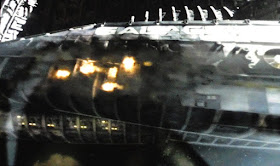
Tyrol makes his grievance regarding Tigh known to Adama calling the XO a "son of a bitch" and that he needed forty seconds to save those men. Adama, supporting his XO informs Tyrol in no uncertain terms. "He's the XO of this ship. Don't you dare forget that. Now he made a tough decision. If it had been me I would have made the same one. Resume your post Chief."
Tigh reports that a weapons depot, Ragnar, is three days away with the Cylon fleet in the middle. Adama plans an FTL hyper light jump. Tigh considers it a risky move. Adama makes the call. Tigh preps the FTL drives. Despite Tigh's protestations regarding the jump, he quickly falls in line behind his commander. Adama knows Tigh is loyal and Adama respects that and looks to instill those same virtues in others including Tyrol. Adama knows backing his XO is a command decision he does not regret.
To make matters worse, the crew receives word that the Battlestar Atlantia, Triton, Columbia, Soloria and others have all been destroyed.

Roslin does not take kindly to Adama's request to regroup at Ragnar for a counterstrike, seeing the fleet and Galactica as a ship needed for responding in more of a rescue posture. As President she orders his attention to her location. And thus begins what will become one of the more fascinating relationship journeys ever committed to television as the hawkish Commander Adama must share the leadership floor with former Secretary of Education Laura Roslin.
Battlestar Galactica is a beautiful if dark work of science fiction. It certainly lacks the nobility and decency of the original, but like that series offers no shortcomings on truth. It simply offers a different perspective on humanity and human behavior. One thing Moore's creation does do is pay these little homages throughout The Mini-Series to the original. But the new series delivers the enemy with a new face.

Appearing as human we have Cylons as the ultimate Trojan Horse. The series offers an alternative version of a now classic story first offered by Glen A. Larson. Things are different now. Fans of the old series can embrace one or both.
Today, we are in a darker place post-911 and the enemy is no longer lined up on battlefields. They are living amongst us. Some Americans even blame American foreign policy in the Middle East completely absolving those that live with those perceptions of any responsibility should they be moved to violence.
Moore's Battlestar Galactica was vital science fiction for a new generation and one that I still have difficulty grappling. It is a disquieting and uneasy journey but one worth taking. This was science fiction with a darkened heart or as the Bear McCreary composition declared, Something Dark Is Coming, and it would begin right here.
That is Serenity from Firefly.























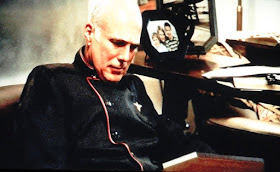






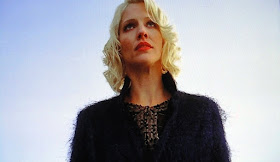
















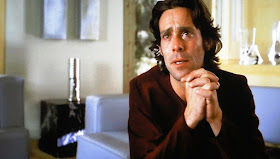



































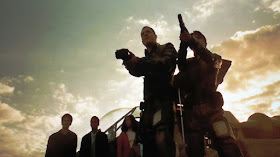

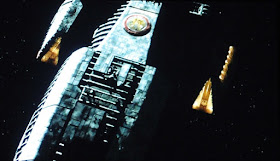






























No comments:
Post a Comment